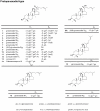Ginsenosides as Anticancer Agents: In vitro and in vivo Activities, Structure-Activity Relationships, and Molecular Mechanisms of Action
- PMID: 22403544
- PMCID: PMC3289390
- DOI: 10.3389/fphar.2012.00025
Ginsenosides as Anticancer Agents: In vitro and in vivo Activities, Structure-Activity Relationships, and Molecular Mechanisms of Action
Abstract
Conventional chemotherapeutic agents are often toxic not only to tumor cells but also to normal cells, limiting their therapeutic use in the clinic. Novel natural product anticancer compounds present an attractive alternative to synthetic compounds, based on their favorable safety and efficacy profiles. Several pre-clinical and clinical studies have demonstrated the anticancer potential of Panax ginseng, a widely used traditional Chinese medicine. The anti-tumor efficacy of ginseng is attributed mainly to the presence of saponins, known as ginsenosides. In this review, we focus on how ginsenosides exert their anticancer effects by modulation of diverse signaling pathways, including regulation of cell proliferation mediators (CDKs and cyclins), growth factors (c-myc, EGFR, and vascular endothelial growth factor), tumor suppressors (p53 and p21), oncogenes (MDM2), cell death mediators (Bcl-2, Bcl-xL, XIAP, caspases, and death receptors), inflammatory response molecules (NF-κB and COX-2), and protein kinases (JNK, Akt, and AMP-activated protein kinase). We also discuss the structure-activity relationship of various ginsenosides and their potentials in the treatment of various human cancers. In summary, recent advances in the discovery and evaluation of ginsenosides as cancer therapeutic agents support further pre-clinical and clinical development of these agents for the treatment of primary and metastatic tumors.
Keywords: Panax genus; Panax ginseng; anticancer activities; clinical trials; ginsenosides; molecular mechanism; pre-clinical pharmacology; structure–activity relationship.
Figures






Similar articles
-
Recent Advances in Ginsenosides as Potential Therapeutics Against Breast Cancer.Curr Top Med Chem. 2019;19(25):2334-2347. doi: 10.2174/1568026619666191018100848. Curr Top Med Chem. 2019. PMID: 31648643 Review.
-
Role of ginsenosides in reactive oxygen species-mediated anticancer therapy.Oncotarget. 2017 Dec 19;9(2):2931-2950. doi: 10.18632/oncotarget.23407. eCollection 2018 Jan 5. Oncotarget. 2017. PMID: 29416826 Free PMC article. Review.
-
Advances on hormone-like activity of Panax ginseng and ginsenosides.Chin J Nat Med. 2020 Jul;18(7):526-535. doi: 10.1016/S1875-5364(20)30063-7. Chin J Nat Med. 2020. PMID: 32616193 Review.
-
Therapeutic potential of Panax ginseng and ginsenosides in the treatment of chronic obstructive pulmonary disease.Complement Ther Med. 2014 Oct;22(5):944-53. doi: 10.1016/j.ctim.2014.08.006. Epub 2014 Aug 20. Complement Ther Med. 2014. PMID: 25440386 Review.
-
Ginsenoside Rc from Korean Red Ginseng (Panax ginseng C.A. Meyer) Attenuates Inflammatory Symptoms of Gastritis, Hepatitis and Arthritis.Am J Chin Med. 2016;44(3):595-615. doi: 10.1142/S0192415X16500336. Epub 2016 Apr 24. Am J Chin Med. 2016. PMID: 27109153
Cited by
-
Integration of CRISPR/Cas9 with multi-omics technologies to engineer secondary metabolite productions in medicinal plant: Challenges and Prospects.Funct Integr Genomics. 2024 Nov 4;24(6):207. doi: 10.1007/s10142-024-01486-w. Funct Integr Genomics. 2024. PMID: 39496976 Review.
-
Effect of the Mediterranean Diet (MeDi) on the Progression of Retinal Disease: A Narrative Review.Nutrients. 2024 Sep 19;16(18):3169. doi: 10.3390/nu16183169. Nutrients. 2024. PMID: 39339769 Free PMC article. Review.
-
The Emerging Role of Natural Products in Cancer Treatment.Arch Toxicol. 2024 Aug;98(8):2353-2391. doi: 10.1007/s00204-024-03786-3. Epub 2024 May 25. Arch Toxicol. 2024. PMID: 38795134 Review.
-
Ginsenoside Rg5 as an anticancer drug: a comprehensive review on mechanisms, structure-activity relationship, and prospects for clinical advancement.Pharmacol Rep. 2024 Apr;76(2):287-306. doi: 10.1007/s43440-024-00586-5. Epub 2024 Mar 25. Pharmacol Rep. 2024. PMID: 38526651 Review.
-
Sustainable production of natural products using synthetic biology: Ginsenosides.J Ginseng Res. 2024 Mar;48(2):140-148. doi: 10.1016/j.jgr.2023.12.006. Epub 2024 Jan 3. J Ginseng Res. 2024. PMID: 38465212 Free PMC article. Review.
References
-
- Barton D. L., Soori G. S., Bauer B. A., Sloan J. A., Johnson P. A., Figueras C., Duane S., Mattar B., Liu H., Atherton P. J., Christensen B., Loprinzi C. L. (2010). Pilot study of Panax quinquefolius (American ginseng) to improve cancer-related fatigue: a randomized, double-blind, dose-finding evaluation: NCCTG trial N03CA. Support. Care Cancer 18, 179–18710.1007/s00520-009-0642-2 - DOI - PMC - PubMed
Grants and funding
LinkOut - more resources
Full Text Sources
Research Materials
Miscellaneous

